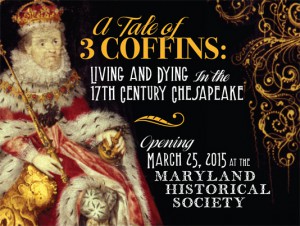 This past summer, the release of images and data discovered in the burials beneath the Jamestowne Colony’s first parish chancel attracted nationwide interest. These were remarkable for their antiquity, the prominent positions the interred colonists had occupied, and the unique reliquary buried with Captain Gabriel Archer.
This past summer, the release of images and data discovered in the burials beneath the Jamestowne Colony’s first parish chancel attracted nationwide interest. These were remarkable for their antiquity, the prominent positions the interred colonists had occupied, and the unique reliquary buried with Captain Gabriel Archer.
A generation after Jamestowne was first settled, a major settlement was made at the northern periphery of the Virginia settlement, along the Chesapeake Bay and inland to the west. In 1990, the lead coffins of St. Mary’s City’s founders, a Calvert husband and wife, were discovered beneath the Jesuit chapel there. While the Jamestowne burials continue to be studied, the seventeenth-century coffins of Chancellor Philip and Anne (Wolseley) Calvert may be visited at the Maryland Historical Society in Baltimore through this, their last weekend there (the exhibit runs through at least 6 December). The genealogical community, and especially the Society of Colonial Wars in the State of Maryland, worked with the Maryland Historical Society, Historic Saint Mary’s City, and the Smithsonian Institution to make this exhibit possible. The Calverts will finally be reinterred at Saint Mary’s City after the exhibit closes next week.
Philip Calvert
Philip Calvert was the son of George Calvert, 1st Baron Baltimore, from his second marriage. When Philip first stepped ashore near Saint Mary’s City in 1656, his older half-brother, Governor Leonard Calvert, had been dead several years and his oldest half-brother, Cecilius, 2nd Lord Baltimore, had other obligations in Great Britain. The senior representative of his family in the New World, he dutifully took up the charge of service to his father and brother’s visionary Maryland colony. Leonard Calvert resided at his manor, Pope’s Freehold, in Saint Mary’s County, and died at a later-acquired estate, Saint Peter’s, late in December 1682.
Anne (Wolseley) Calvert
Calvert’s wife Anne Wolseley, daughter of Sir Thomas Wolseley of Staffordshire, accompanied him to Maryland in 1656. The treatment of her body before it was interred has been widely remarked upon: as a Maryland State Archives staffer put it, “ [she was] buried with such tender loving care – arms folded and tied with silk ribbon, rosemary, the herb of remembrance sprinkled lovingly over her body.” She died in about 1680.
Philip and Anne (Wolseley) Calvert left no identified descendants. The presence of the third coffin, belonging to an infant, leaves some question as to whether Philip might have produced a child in his brief marriage to a second wife, Jane Sewall, daughter of Henry and Jane (Lowe) Sewall.
Several of Philip’s half-siblings, children of the 1st Lord Baltimore by his first wife, Anne (Mynne) Calvert, left descendants, including the later Lords Baltimore. While descendants continued to marry British nobles and gentry, many, too, married among the leading Catholic families of Maryland. By the twenty-first century, they can be found among the ancestors of many thousands of Americans with colonial Mid-Atlantic and Southern ancestry.
For more information, see the Smithsonian Institution—National Museum of Natural History’s interactive website on the Saint Mary’s City chapel site where the coffins were recovered.
References at NEHGS:
- Hester Dorsey Richardson, Side-lights on Maryland History with Sketches of Early Maryland Families (1913; reprint, Baltimore: Genealogical Publishing Company, 1995).
- George Ely Russell and Donna Valley Russell, eds., The Ark and The Dove Adventurers (Baltimore: GPC, 2005).
- John Frederick Dorman, comp., Adventurers of Purse and Person: Virginia, 1607-1624/5, 4th ed., Vol. 1 (Baltimore: GPC, 2004).
- John D. Krugler, English and Catholic: The Lords Baltimore in the Seventeenth Century, The Johns Hopkins University Studies in Historical and Political Science (Baltimore: Johns Hopkins University Press, 2004).
- Edward D. Neill, Terra Mariæ: or Threads of Maryland Colonial History (1867; reprint, Salem, Mass.: Higginson, 1997).
- Neill, The Founders of Maryland: As Portrayed in Manuscripts, Provincial Records, and Early Documents (1876; reprint, Salem, Mass.: Higginson, 1997).
- William McSherry, A Relation of the Colony of the Lord Baron of Baltimore in Maryland, near Virginia; A Narrative of the Voyage to Maryland by Father Andrew White; and Sundry Reports from Fathers Andrew White, John Altham, John Brock, and other Jesuit Fathers of the Colony to the Superior General at Rome (Washington, D.C., 1846).
Share this:
About Christopher Carter Lee
Christopher Carter Lee completed undergraduate studies in international relations at Georgetown University in Washington, D.C., where he focused on culture and politics. He previously worked in foreign policy research, special projects and development for a U.S. Senate office, and as a political consultant, appearing on CNN's Crossfire. More recently, he built his own hired genealogical research practice while consulting in program development before joining NEHGS Research Services. He holds a Certificate in Genealogical Research from Boston University and has extensive knowledge of Maryland, Virginia, Southern U.S., and Southeastern American Indian genealogy, the Catholic Church in North America, and expertise in Italian, French, Polish, Russian, and other European research, nobility, heraldry, and history.View all posts by Christopher Carter Lee →